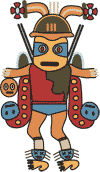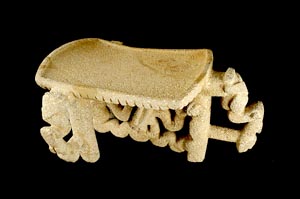 |
Welcome to teaching with objects: The Articulate Object. We hope you and your students will enjoy the active process of looking, questioning and investigating an object left for us by the Ancient Americans. |
 |
Flying-Panel Metate |
Objectives: Students will:
-
gather information by closely observing images of historical art objects to describe and identify details of materials, construction, daily use, decoration and symbolism.
-
make hypotheses about the culture which produced the object.
-
test their ideas by integrating what they observe with the information they gather from Odyssey Online, their textbooks, and classroom discussion.
-
gain understanding of the culture that produces and uses the object.
Curriculum connections: Art, Social Studies
Materials Needed
-
Object: The images and label information may be downloaded and printed on paper or transparencies, or students could look at the images online.
-
Object Analysis Worksheet: this student worksheet can be downloaded and printed for each student.
-
Teacher’s Object Analysis Worksheet: this teacher’s guide includes information that supplements the observations students can make from the images.
Teacher Directions:
-
Make pictures of the object and its label information available for the students to examine.
Download and print copies of the Object Analysis Worksheet for the students..
-
Instruct the students to complete worksheet sections 1 & 2 by carefully observing the object and reading the label information. If they cannot see enough detail to answer all the questions, they should record an “educated guess” or suggest how they might find the answer elsewhere. The lesson’s objective is to look carefully and thoughtfully for important information.
-
Instruct students to complete worksheet sections 3 & 4; these sections require students to integrate what they have observed with knowledge they already possess about similar objects or cultures they have studied.
-
Once students have observed closely, they are ready to discuss their hypotheses and conclusions. The teacher version of the Object Analysis Worksheet has information that can be introduced to the students to supplement their observations and enhance the discussion.
-
Close observation of these objects raises thoughtful questions and issues which you and the students may want to pursue.
Student Directions:
-
Look carefully and thoughtfully at the object. Historians learn about the peoples of other times by examining similar objects, clues to the past. Often there is no writing to help us know what they are or how they were used, so we have to “read” the object.
-
Record what you see as well as the questions you have.
-
As you look at the objects, there may be information you learned in class or in Odyssey Online that will give you more ideas about these objects. Try to figure out how these objects were used, or who made them, or why they were made. Through the objects you can learn how people lived in other times and places.